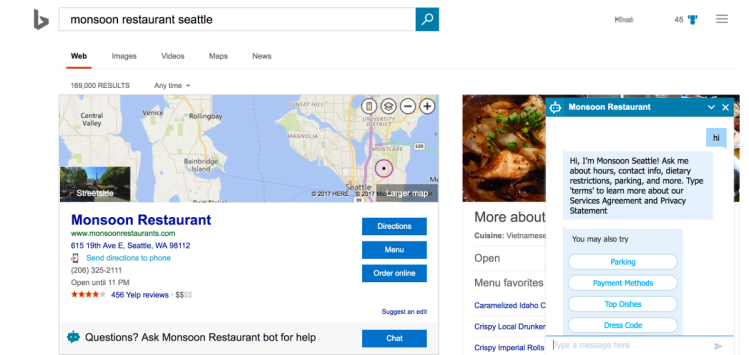The Bing search engine can now surface Skype bots in its search results when you search for a business.
The news was announced today at Build, Microsoft’s annual developer conference, taking place May 10-12 in Seattle. The Microsoft Bot Framework, a toolkit for creating bots for more than half a dozen chat apps and Bing.com, was first launched at Build in San Francisco last year.
Hints of bots in Bing search results first occurred last month and again last week.
To test the bots on Bing feature, search “Monsoon Restaurant Seattle” now and try out the experience.
June 5th: The AI Audit in NYC
Join us next week in NYC to engage with top executive leaders, delving into strategies for auditing AI models to ensure fairness, optimal performance, and ethical compliance across diverse organizations. Secure your attendance for this exclusive invite-only event.
The bots pop up on Bing.com in the bottom right-hand corner of the screen, similar to a Facebook Messenger or Google Hangouts message notification. Any conversations with the bot automatically carries over and can be continued on Skype.
Bots on Bing will begin with businesses, but experimentation may happen with other kinds of bots and popular search destinations.
Bing began adding bots to its search engine by speaking with businesses with high search traffic and reminding them of the sorts of questions people were asking about their business in search.
VentureBeat and other news outlets reported last week that the possibility of bots in Bing search results
Microsoft also announced Wednesday that its Cortana Skill Kit is now publicly available so developers can begin to create voice apps for the intelligent assistant. Changes are also expected for Microsoft Bot Framework, and Microsoft Cognitive Services, which can supply the AI smarts for bots.
Lili Cheng is general manager of Fuse Labs at Microsoft Research, the group that created the Microsoft Bot Framework and bots like the famous Xiaoice and the infamous Tay bot.
The Bing team is beginning to promote bots to business owners by reminding them of the traffic they receive, the kinds of questions patrons are asking about a business, and how a bot may be able to address these questions.
Standards will be important for businesses using Bing on bots so that people can understand the experience they’re having. Bot experiences today range from a natural language processing bot that text-chats to an NLP-free guided experience with buttons and cards. Some combine the two interfaces, while chat extensions on Facebook Messenger only operate in webview.
Cheng says even after a year of bots on Microsoft devices, a lot of people still don’t know what bots do. Using a standard format and approach will help consumers get familiar with what to expect when speaking to a business’ bot.
Another advantage Bing has is that it can act as kind of a directory for bots. In addition to finding bots on the search result page for a business, Bing users will be able to search for bots overall and bots by categories.
A search engine for bots is an idea Cheng first shared with VentureBeat last fall, and she said Microsoft continues to talk with partners like Slack and Facebook.
“They show you how people interact with a bot that they’d never interact with in search, because in search you’re just trying to type in a word and click and you’re on the restaurant page,” she said. “When they click on the bot, they engage a lot more, and I think what we’re doing is also we’re able to give the businesses more data about how people interact with them.”


